Charing Cross Hospital
Agar Street, West Strand, WC2N 4JP
Medical dates:
Medical character:
1818 - 1973
Acute.
Teaching Hospital.
In 1815 Dr. Benjamin Golding (1793-1863), moved by the poverty surrounding the area where he lived, threw open his own house in Leicester Place to "such poor persons as deserve gratuitous advice". The area contained some of the worst slums in London. In Wild Court, off Kingsway, some 1,000 people lived in 13 houses.
in 1818 the 24-year-old Dr Golding, together with his friend John Robertson, established the West London Infirmary and Dispensary at No. 16 Suffolk Street, behind the Haymarket Theatre. The Duke of York agreed to become its Patron, after which it was known as the Royal West London Infirmary and Dispensary.
By 1821 the premises had become inadequate as the Infirmary was treating almost 10,000 patients a year. In 1823 it moved to a larger building at No. 28 Villiers Street, where it had 12 beds. In 1827 the Infirmary's name was changed to Charing Cross Hospital and plans were made to build a much larger hospital nearby. In 1830 a site in Agar Street, just off the Strand, was offered by the government, with an annual ground rent of £400.
The foundation stone for the new Hospital was laid on 15th September 1831 by the Duke of Sussex.
Completed in January 1834 at a cost of £20,000, the new
Hospital opened to in-patients on 10th February. It had 60 beds
and there was also
accommodation for 22 medical students. The first ward to be
completed was named after the daughter of the Duchess of Kent, Princess
Victoria (later Queen Victoria), while the main male ward was named
Golding Ward, after the Hospital's founder.
The building was extended in 1840 and, in 1850, the freehold was
purchased. The third floor of the Hospital, which had been left
as an empty shell, was completed in 1854.
In 1862 children's wards opened and, in 1867, the Hospital was extended again.
In 1877 much of the Hospital was rebuilt and enlarged, doubling its size. It then had 120 beds. The new wards were opened by the Prince and Princess of Wales.
In 1885 the Hospital was extended again and, in 1888, the first Matron and Sisters engaged.
In 1896 a Convalescent Home opened in Limpsfield, financed by the Cornish philanthropist, John Passmore Edwards, who had donated £5,000 towards the project in 1891 on the condition that the Home remain under the control of the Governors and Council of the Hospital in perpetuity.
In 1902 the foundation stone was laid by the Duke of Connaught and his sister, Princess Louise, for a further extension of the Hospital.
At the outbreak of WW1 in 1914 five wards (empty due to financial restrictions) containing some 90 beds, were placed at the disposal of the War Office for sick and wounded soldiers. The nursing staff was increased from 64 to 85 nurses. By 1916 half of the Hospital's 300 available beds were given over to military casualties.
In 1925 a new floor was added to the Hospital building. In 1926 the Royal Westminster Ophthalmic Hospital in King William Street (now William IV Street) was purchased for £70,000, after which the Hospital owned the whole of the island site.
In 1930 another extension - the Columbia Wing, with two wards of 20 beds, opened; it was endowed by American subscriptions.
A new Nurses' Home in Englands Lane, Haverstock Hill, opened in 1932. It had cost £108,000 to build.
By 1934 the site in Agar Street had become cramped, but there was no more possibility of expansion. The site of the Adelphi Theatre was being considered for a new hospital, but the site proved too expensive and the plan was dropped.
The Hospital was reserved for war casualties. In 1942 an appointment system was introduced in the Out-Patients Department.
The building survived relatively intact from the war, although an incendiary bomb in 1940 had caused some damage.
After WW2 it was decided that the Hospital should move out of central London. (In 1944 the government had announced plans for the rebuilding of the Hospital at Northwick Park, Harrow.) In 1947 three wards were taken over at Mount Vernon Hospital for gynaecological and medical patients.
The Hospital joined the NHS in 1948 as a designated teaching hospital. It had 300 beds (and 144 at Mount Vernon Hospital). In 1951 the Gattis restaurant in William IV Street was taken over for use as pathology laboratories. In 1952 the Kingsbury Maternity Hospital, Harrow Hospital and Wembley Hospital joined the Charing Cross Hospital Group. However, the University of London decided it could not remain affiliated with the Hospital if it moved to Northwick Park, so the scheme was abandoned. (The site was handed over to the Ministry of Health and the current Northwick Park Hospital was built there in 1960.)
In 1957 the Ministry of Health proposed that the Hospital be rebuilt on the site of Fulham Hospital in St Dunstan's Road, Hammersmith, several miles west of the city centre. Despite local protests, the plan went ahead. In 1959 the Fulham Hospital, Fulham Maternity Hospital and West London Hospital joined the Charing Cross Hospital Group, while the Kingsbury Maternity, Harrow and Wembley Hospitals left it.
In 1959 an Out-Patients Physiotherapy Department opened in Villiers House, Strand, and in 1960 Temple Hill House in Hampstead was taken over as the Psychiatric Unit.
In 1963 work began on the new Hospital in Fulham and its foundation stone was laid on May 1968 by Lord Inman, the Chairman of Charing Cross Hospital.
The Hospital closed in 1973, when the new £15m Charing Cross Hospital (Fulham) opened.
|
Present status
(November 2007) |
|---|
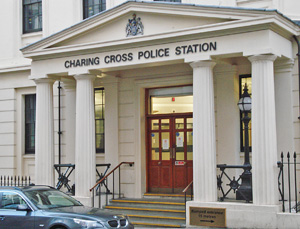
The main entrance of the former Hospital, now the Charing Cross Police Station, in Agar Street.
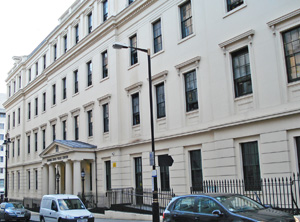
Looking towards the Strand down Agar Street (above) and William IV Street (below).
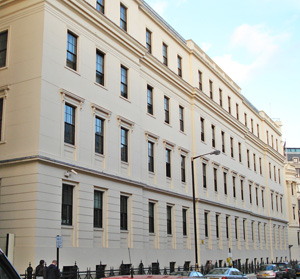

The former Hospital at the junction of William IV Street and Agar Street, as seen from the Strand.
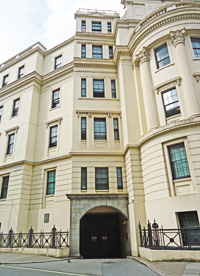
The entrance to the former Casualty Department, with a plaque commemorating the Hospital on the wall to the left.
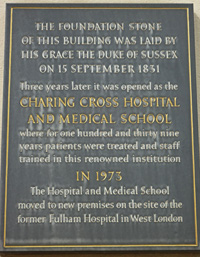
The commemorative plaque.
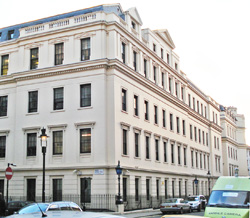
The corner of Agar St (on the left) and Chandos Place (on the right.
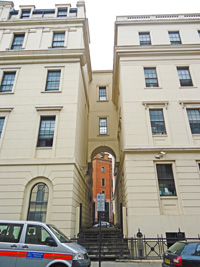
Looking from William IV Street towards Chandos Place through the alley between the front and back of the former Hospital. The left hand building was once the Royal Westminster Ophthalmic Hospital. The upper levels are connected by a bridge.
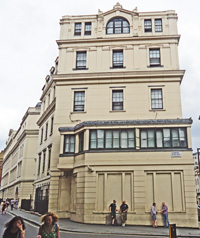
The original foundation stone (below) for the Royal Westminster Ophthalmic Hospital remains at the base of the west corner of the building in Chandos Place (above).
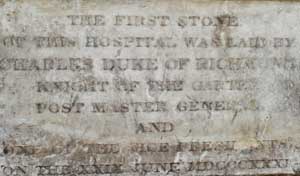

The Nurses' Home was later taken over by the Royal Free Hospital. It is now Englands Lane Hostel, leased by Camden for homeless people.
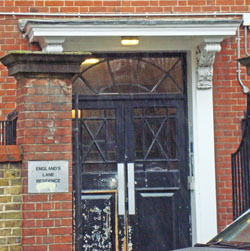
The main entrance to the Hostel.
References (Accessed 11th July 2014)
(Author unstated) 1891 Nursing Echoes.The Nursing Record, 26th November, 276.
(Author unstated) 1915 Charing Cross Hospital. British Journal of Nursing, 23rd January, 75-76.
(Author unstated) 1916 Care of the wounded. British Journal of Nursing, 8th April, 315.
(Author unstated) 1928 The hospital world. British Journal of Nursing (May), 124.
(Author unstated) 1930 The hospital world. British Journal of Nursing (June), 163.
(Author unstated) 1932 The hospital world. British Journal of Nursing (May), 133.
(Author unstated) 1936 The hospital world. British Journal of Nursing (May), 132.
(Author unstated) 1939 The year's work at Charing Cross Hospital. British Journal of Nursing (July), 189.
Barry G, Carruthers LA 2005 A
History
of Britain's Hospitals. Sussex, Book Guild Publishing.
Black N 2006 Walking London's Medical History.
London, Royal Society of Medicine Press.
Hunter W 1914 Historical account of Charing Cross Hospital and Medical School. London, Murray.
http://archive.spectator.co.uk
http://collage.cityoflondon.gov.uk